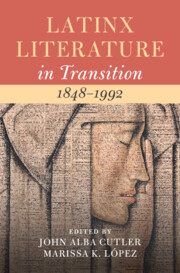Book contents
- Latinx Literature in Transition, 1848–1992
- Latinx literature in transition
- Latinx Literature in Transition, 1848–1992
- Copyright page
- Dedication
- Contents
- Figures
- Contributors
- Acknowledgments
- Introduction
- Part I Space
- Part II Being
- Part III Time
- Part IV Form
- Part V Labor
- Chapter 17 Seeking Parteras in the Archive
- Chapter 18 The Work of War
- Chapter 19 Farmworker Culture in Literature and Film, or Tomás Rivera’s Brown Noir
- Chapter 20 The Specter of Neoliberalism
- Bibliography
- Index
- References
Chapter 20 - The Specter of Neoliberalism
Labor, Activism, and Commodity Abstraction in Early Chicano/a Literature
from Part V - Labor
Published online by Cambridge University Press: 10 April 2025
- Latinx Literature in Transition, 1848–1992
- Latinx literature in transition
- Latinx Literature in Transition, 1848–1992
- Copyright page
- Dedication
- Contents
- Figures
- Contributors
- Acknowledgments
- Introduction
- Part I Space
- Part II Being
- Part III Time
- Part IV Form
- Part V Labor
- Chapter 17 Seeking Parteras in the Archive
- Chapter 18 The Work of War
- Chapter 19 Farmworker Culture in Literature and Film, or Tomás Rivera’s Brown Noir
- Chapter 20 The Specter of Neoliberalism
- Bibliography
- Index
- References
Summary
Ernesto Galarza’s Merchants of Labor: The Mexican Bracero Story is a genealogical study of the Mexican migrant farmworker experience in California under the Bracero Program. His study was a direct response to the deaths of thirty-two migrant workers in the Chualar bus crash of 1963. Galarza traces the political-economic origin “story” of this labor force and its role within a historical moment defined by rapid increases in modernization. Of considerable importance are his insights regarding the central characteristics of an emerging neoliberal paradigm, which are brilliantly grounded in his analysis of how Mexican braceros were transformed into a disembodied “labor pool” for US agribusiness. The chapter examines Galarza’s critique of the Bracero Program and his analysis of early farmworker struggles against exploitative labor practices, particularly the manner in which “labor pools” were used to transform the concrete existentiality of the bracero into a commodity abstraction, thus establishing a blueprint for the systemic exploitation of racially marginalized peoples. The chapter concludes by addressing how Chicana/o activists affiliated themselves with the farmworker struggle after the Chualar tragedy, thus bridging the rural–urban divide while calling attention to the movement’s anti-war protests and demands for political reform.
Keywords
- Type
- Chapter
- Information
- Latinx Literature in Transition, 1848–1992 , pp. 349 - 364Publisher: Cambridge University PressPrint publication year: 2025

